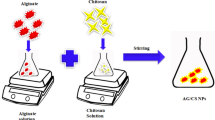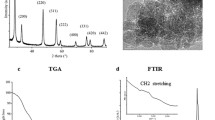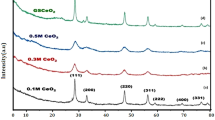Abstract
Cerium oxide nanoparticles were synthesized by thermal decomposition of cerium alginate biopolymer gel at 450 °C, where alginate both acts as a precursor and a template. The synthesis is a green, facile and one-step method and the resulting nanoparticles have functionalized surface. The resulted material were characterized using X-ray diffraction for confirmation of cerium oxide, crystallite size analysis and grain size distribution. Transmission electron microscopy was used for the particle size determination, hydrodynamic size estimation was studied by dynamic light scattering and surface characteristics were analyzed using zeta potential measurements. Results show the presence of spherical particles with a size of < 5 nm. Having only a negative surface charge in such a wide pH range will ensure that the behavior of obtained nanoparticles in different environments is predictable. Isoelectric point of the synthesized material is significantly different from non-functionalized cerium oxide, and indicates the surface functionality, which is an important property for biocompatibility.








Similar content being viewed by others
References
Akin Evingür G, Kaygusuz H, Erim FB, Pekcan Ö (2014) Effect of calcium ion concentration on small molecule desorption from alginate beads. J Macromol Sci Part B 53:1157–1167
Alpaslan E, Yazici H, Golshan NH, Ziemer KS, Webster TJ (2015) pH-dependent activity of dextran-coated cerium oxide nanoparticles on prohibiting osteosarcoma cell proliferation. ACS Biomater Sci Eng 1:1096–1103. https://doi.org/10.1021/acsbiomaterials.5b00194
Babitha KK, Sreedevi A, Priyanka KP, Sabu B, Varghese T (2015) Structural characterization and optical studies of CeO2 nanoparticles synthesized by chemical precipitation. Indian J Pure Appl Phys 53:596–603
Baskoutas S, Giabouranis P, Yannopoulos SN, Dracopoulos V, Toth L, Chrissanthopoulos A, Bouropoulos N (2007) Preparation of ZnO nanoparticles by thermal decomposition of zinc alginate. Thin Solid Films 515:8461–8464
Bhatnagar S, Kobori T, Ganesh D, Ogawa K, Aoyagi H (2019) Biosynthesis of silver nanoparticles mediated by extracellular pigment from talaromyces purpurogenus and their biomedical applications. Nanomaterials 9:1042
Caputo F, Mameli M, Sienkiewicz A, Licoccia S, Stellacci F, Ghibelli L, Traversa E (2017) A novel synthetic approach of cerium oxide nanoparticles with improved biomedical activity. Sci Rep 7:4636
Caputo F, Giovanetti A, Corsi F, Maresca V, Briganti S, Licoccia S, Traversa E, Ghibelli L (2018) Cerium oxide nanoparticles reestablish cell integrity checkpoints and apoptosis competence in irradiated HaCaT cells via novel redox-independent activity. Front Pharmacol 9:1183
Celardo I, De Nicola M, Mandoli C, Pedersen JZ, Traversa E, Ghibelli L (2011) Ce 3+ ions determine redox-dependent anti-apoptotic effect of cerium oxide nanoparticles. ACS Nano 5:4537–4549
Chuang J-J, Huang Y-Y, Lo S-H, Hsu T-F, Huang W-Y, Huang S-L, Lin Y-S (2017) Effects of pH on the shape of alginate particles and its release behavior. Int J Polym Sci 2017:1–9
Corma A, Atienzar P, García H, Chane-Ching J-Y (2004) Hierarchically mesostructured doped CeO2 with potential for solar-cell use. Nat Mater 3:394–397
Dhall A, Self W (2018) Cerium oxide nanoparticles: a brief review of their synthesis methods and biomedical applications. Antioxidants 7:97
Giri S, Karakoti A, Graham RP, Maguire JL, Reilly CM, Seal S, Rattan R, Shridhar V (2013) Nanoceria: a rare-earth nanoparticle as a novel anti-angiogenic therapeutic agent in ovarian cancer. PLoS One 8:e54578
Grant GT, Morris ER, Rees DA, Smith PJC, Thom D (1973) Biological interactions between polysaccharides and divalent cations: the egg-box model. FEBS Lett 32:195–198
Gulicovski JJ, Bračko I, Milonjić SK (2014) Morphology and the isoelectric point of nanosized aqueous ceria sols. Mater Chem Phys 148:868–873
He H-W, Wu X-Q, Ren W, Shi P, Yao X, Song Z-T (2012) Synthesis of crystalline cerium dioxide hydrosol by a sol–gel method. Ceram Int 38:S501–S504
Hirano M, Fukuda Y, Iwata H, Hotta Y, Inagaki M (2004) Preparation and spherical agglomeration of crystalline cerium(IV) oxide nanoparticles by thermal hydrolysis. J Am Ceram Soc 83:1287–1289
Hirst SM, Karakoti AS, Tyler RD, Sriranganathan N, Seal S, Reilly CM (2009) Anti-inflammatory properties of cerium oxide nanoparticles. Small 5:2848–2856
Holmgren A, Andersson B, Duprez D (1999) Interactions of CO with Pt/ceria catalysts. Appl Catal B Environ 22:215–230
Huang X, Li L-D, Lyu G-M, Shen B-Y, Han Y-F, Shi J-L, Teng J-L, Feng L, Si S-Y, Wu J-H, Liu Y-J, Sun L-D, Yan C-H (2018) Chitosan-coated cerium oxide nanocubes accelerate cutaneous wound healing by curtailing persistent inflammation. Inorg Chem Front 5:386–393
Ivanov VK, Shcherbakov AB, Usatenko AV (2009) Structure-sensitive properties and biomedical applications of nanodispersed cerium dioxide. Russ Chem Rev 78:855–871
Jung H, Kittelson DB, Zachariah MR (2005) The influence of a cerium additive on ultrafine diesel particle emissions and kinetics of oxidation. Combust Flame 142:276–288
Kannan SK, Sundrarajan M (2014) A green approach for the synthesis of a cerium oxide nanoparticle: characterization and antibacterial activity. Int J Nanosci 13:1450018
Karakoti AS, Singh S, Kumar A, Malinska M, Kuchibhatla SVNT, Wozniak K, Self WT, Seal S (2009) PEGylated nanoceria as radical scavenger with tunable redox chemistry. J Am Chem Soc 131:14144–14145
Kargar H, Ghazavi H, Darroudi M (2015) Size-controlled and bio-directed synthesis of ceria nanopowders and their in vitro cytotoxicity effects. Ceram Int 41:4123–4128
Kaygusuz H, Erim FB (2013) Alginate/BSA/montmorillonite composites with enhanced protein entrapment and controlled release efficiency. React Funct Polym 73:1420–1425
Kaygusuz H, Bilir G, Tezcan F, Erim FB, Özen G (2014) Biopolymer-assisted synthesis of yttrium oxide nanoparticles. Particuology 14:19–23
Kaygusuz H, Torlak E, Akın-Evingür G, Özen İ, von Klitzing R, Erim FB (2017) Antimicrobial cerium ion-chitosan crosslinked alginate biopolymer films: a novel and potential wound dressing. Int J Biol Macromol 105:1161–1165
Korsvik C, Patil S, Seal S, Self WT (2007) Superoxide dismutase mimetic properties exhibited by vacancy engineered ceria nanoparticles. Chem Commun 10:1056
Ksapabutr B, Gulari E, Wongkasemjit S (2004) One-pot synthesis and characterization of novel sodium tris(glycozirconate) and cerium glycolate precursors and their pyrolysis. Mater Chem Phys 83:34–42
Lee SS, Zhu H, Contreras EQ, Prakash A, Puppala HL, Colvin VL (2012) High temperature decomposition of cerium precursors to form ceria nanocrystal libraries for biological applications. Chem Mater 24:424–432
Munusamy S, Bhakyaraj K, Vijayalakshmi L, Stephen AR, Narayanan V (2014) Synthesis and characterization of cerium oxide nanoparticles using Curvularia lunata and their antibacterial properties. Int J Innov Res Sci Eng 2:318
Oriekhova O, Stoll S (2016) Effects of pH and fulvic acids concentration on the stability of fulvic acids–cerium (IV) oxide nanoparticle complexes. Chemosphere 144:131–137
Perez JM, Asati A, Nath S, Kaittanis C (2008) Synthesis of biocompatible dextran-coated nanoceria with pH-dependent antioxidant properties. Small 4:552–556
Pielaszek R (2004) FW15/45 M method for determination of the grain size distribution from powder diffraction line profile. J Alloys Compd 382:128–132
Qi L, Fresnais J, Muller P, Theodoly O, Berret J-F, Chapel J-P (2012) Interfacial activity of phosphonated-peg functionalized cerium oxide nanoparticles. Langmuir 28:11448–11456
Samai B, Basu A, Mati SS, Bhattacharya SC (2019) Antiamyloid activity of functionalized cerium oxide nanoparticle on lysozyme fibrillation: spectroscopic and microscopic investigation. Materialia 6:100285
Schneider CA, Rasband WS, Eliceiri KW (2012) NIH Image to ImageJ: 25 years of image analysis. Nat Methods 9:671–675
Sehgal A, Lalatonne Y, Berret JF, Morvan M (2005) Precipitation-redispersion of cerium oxide nanoparticles with poly (acrylic acid): toward stable dispersions. Langmuir 21:9359–9364
Singh C, Friedrichs S, Ceccone G, Gibson P, Jensen KA, Levin M, Goenaga Infante H, Carlander D, Rasmussen K (2014) Cerium dioxide, NM-211, NM-212, NM-213. Characterisation and test item preparation. In: JRC repository: NM-series of representative manufactured nanomaterials. http://publications.jrc.ec.europa.eu/repository/handle/JRC89825
Siposova K, Huntosova V, Shlapa Y, Lenkavska L, MacAjova M, Belous A, Musatov A (2019) Advances in the study of cerium oxide nanoparticles: new insights into antiamyloidogenic activity. ACS Appl Biol Mater 2:1884–1896
Uyar G, Kaygusuz H, Erim FB (2016) Methylene blue removal by alginate–clay quasi-cryogel beads. React Funct Polym 106:1–7
Vassie JA, Whitelock JM, Lord MS (2018) Targeted delivery and redox activity of folic acid-functionalized nanoceria in tumor cells. Mol Pharm 15:994–1004
Vayssilov GN, Mihaylov M, St Petkov P, Hadjiivanov KI, Neyman KM (2011) Reassignment of the vibrational spectra of carbonates, formates, and related surface species on ceria: a combined density functional and infrared spectroscopy investigation. J Phys Chem C 115:23435–23454
Wang Y, Mori T, Li J-G, Ikegami T (2004) Low-temperature synthesis of praseodymium-doped ceria nanopowders. J Am Ceram Soc 85:3105–3107
Wang W, Howe JY, Li Y, Qiu X, Joy DC, Paranthaman MP, Doktycz MJ, Gu B (2010) A surfactant and template-free route for synthesizing ceria nanocrystals with tunable morphologies. J Mater Chem 20:7776
Wang J, Li Z, Zhang S, Yan S, Cao B, Wang Z, Fu Y (2018) Enhanced NH3 gas-sensing performance of silica modified CeO2 nanostructure based sensors. Sens Actuators B Chem 255:862–870
Yang H, Zhou Q, Luo W, Yan C, Zhou C (2016) The preparation of a cross-linked cerium (III)-loaded alginate bead adsorbent for the removal of phosphate from wastewater. Desalin Water Treat 57:18354–18365
Yu S, Chow GM (2004) Carboxyl group (–CO2H) functionalized ferrimagnetic iron oxide nanoparticles for potential bio-applications. J Mater Chem 14:2781–2786
Zhang H, He X, Zhang Z, Zhang P, Li Y, Ma Y, Kuang Y, Zhao Y, Chai Z (2011) Nano-CeO2 exhibits adverse effects at environmental relevant concentrations. Environ Sci Technol 45:3725–3730
Author information
Authors and Affiliations
Corresponding author
Ethics declarations
Conflict of interest
On behalf of all authors, the corresponding author states that there is no conflict of interest.
Additional information
Publisher's Note
Springer Nature remains neutral with regard to jurisdictional claims in published maps and institutional affiliations.
Rights and permissions
About this article
Cite this article
Kaygusuz, H., Erim, F.B. Biopolymer-assisted green synthesis of functional cerium oxide nanoparticles. Chem. Pap. 74, 2357–2363 (2020). https://doi.org/10.1007/s11696-020-01084-7
Received:
Accepted:
Published:
Issue Date:
DOI: https://doi.org/10.1007/s11696-020-01084-7




